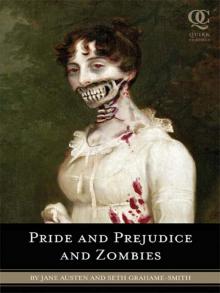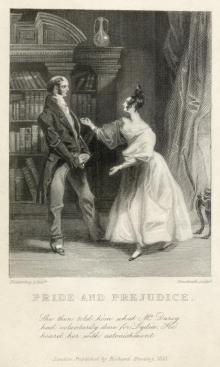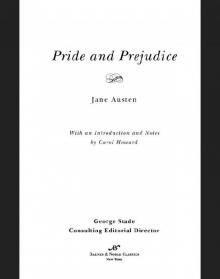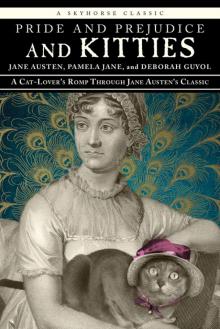- Home
- Jane Austen
The Annotated Persuasion Page 2
The Annotated Persuasion Read online
Page 2
Yet, as understandable as this scruple is, it creates difficulties in novels that center around the union of a man and a woman. Each must naturally come to love the other and to regard marriage to the other as feasible and desirable. This usually means, for both, a process of growth and enlightenment. Yet inevitably Jane Austen presents only one-half of the story in detail. The reader follows every twist and turn of the woman’s thoughts and feelings concerning the man but remains mostly ignorant of his thoughts and feelings, except for what can be discerned through his outward behavior. It is only at the end of each novel, after the lovers’ union has been assured, that a retrospective history of the man’s emotional evolution is provided. Since this evolution is generally as eventful and interesting as the woman’s, its abbreviated presentation represents a definite loss. This loss is particularly acute in Sense and Sensibility and Pride and Prejudice, for their plots require the hero to spend much of the novel away from the heroine, and thus away from the reader’s awareness as well. In Northanger Abbey the hero is more continually present, but the heroine’s lack of familiarity with him means that his inner thoughts remain murky. Finally, Mansfield Park and Emma both involve heroes who are close friends with the heroine throughout the story, thus allowing their characters to be fully presented, but because each story hinges upon either the hero or the heroine regarding the other solely as a friend and close relation, and focusing on other objects of interest, the issue of a romantic union of the two is barely raised.
Persuasion is the one Austen novel to avoid these limitations. The past affair between Anne and Captain Wentworth ensures attention throughout to the issue of their feelings toward each other—he is always a figure of potential romance. In addition, this past affair, in which they briefly achieved a full and intimate union of souls, ensures that Anne is highly interested in him and able to draw upon a deep knowledge of his character. Throughout the novel, even when Captain Wentworth is holding himself aloof from Anne, her mind offers a continual stream of observations on him, observations that consistently prove correct. She can guess his reactions and motivations on particular occasions and reflect on his general state. The end of the novel contains, like the others, a summary of his prior evolution, but in this case the summary, at least on the central question of his feelings toward Anne, only confirms what has already been suggested rather than reveals new information. All this means that Captain Wentworth, despite the novel’s brevity and his aloofness or absence for much of it, is one of the most, if not the most, fully realized of all Jane Austen’s heroes.
These advantages of Persuasion’s distinctive romantic plot are accompanied, however, by important disadvantages. One of these is the limited nature of the plot. A principal reason for the novel’s brevity is that it has by far the thinnest story of any Austen novel, with the possible exception of Northanger Abbey, whose satirical and comical nature makes story matter less. In all the others the plot has many twists and turns, since its central romance effectively starts from scratch. The two lovers either do not know each other at the outset, or they have come to know each other so well in a nonromantic context that it requires a major adjustment by at least one of the two to think of the other in a different sense. This creates many possibilities for one or both of the potential lovers to be diverted by an involvement with a third person, a misunderstanding of the other’s character or intentions, or a failure to imagine even the possibility of this romance. The development of these distractions or barriers, and the eventual triumph over them, provide ample material for incident and story.
In contrast, by having a pair of lovers who came close to marriage earlier and who still harbor powerful affection for each other, even if this affection has been suppressed by resentment in one case, Persuasion has limited means of delaying or complicating their eventual union. Once events have brought Anne and Captain Wentworth in close proximity again, the course is basically set. All that is really needed is sufficient time to soften old bitterness and to remind the person harboring this bitterness of the worth of the other. Rivals—Louisa Musgrove and William Elliot—do appear. But since both Anne and Captain Wentworth have already been reexposed to each other, neither can really become attracted to the rival. That could happen only if one of them lacked the true love for the other that they both ultimately manifest and acknowledge. The only way to lengthen the plot, while preserving the characters of the two principals, would be to introduce improbable contrivances that impede their union or to expand the treatment of supporting characters and subplots to the point that the story of the principals becomes obscured. Wisely avoiding such expedients, Jane Austen is left with a beautiful but slim tale.
Another handicap of the tale is the passive role it necessarily imposes on its main character. Though Anne Elliot forms the complete focus of the novel, she does very little. This contrasts to other Jane Austen heroines. Those who are flawed have much to do, first in committing their serious errors and then in suffering the consequences, realizing their mistakes, and making amends. Even the two other relatively faultless heroines, Elinor Dashwood and Fanny Price, are given a far more active role in the plot. Elinor has to fall in love, learn that her lover is engaged elsewhere, fend off the sneers and barbs of her rival, and cope with her apparent definitive loss before being finally united with him. She also has to devote considerable effort to coping with her sister’s woes, which constitute half the plot. As for Fanny Price, she is forced to resist, in the face of considerable temptation and pressure from those she loves, the prolonged and persistent courtship of a man she disapproves of. She also is given the tasks of observing and detecting an all-important illicit entanglement that nobody else discerns, and of revising significantly her long-held nostalgia for her original home.
Anne Elliot has almost nothing like this to do. The mistake she suffers from occurred in the past, and she has fully absorbed its lesson when the action begins. Her feelings for Captain Wentworth are already set, and she has no important discoveries to make about herself. She does not observe anything of great significance not witnessed by others; her superior insights into Captain Wentworth’s mind result primarily from her state of prior knowledge, not from anything that she does over the course of the novel. Nor does she need to cope with or overcome any major external difficulties. The sole exceptions are the falls of her nephew and of Louisa, both brief episodes and only the second of which is important to the plot. She also has to deliberate over the desirability of William Elliot’s attentions and to alert Captain Wentworth to her continued interest in him, but the first takes little time or mental effort, and the second involves only two relatively brief conversations in the final chapters. Otherwise she watches, waits, reflects on her situation and on Captain Wentworth, controls her feelings as best she can, and engages in the usual trivialities of everyday life.
This poses a challenge to maintenance of continued interest in the heroine. It also limits how much attention can be paid to other characters, for doing so could make them overshadow a main character with little active function. Thus, while Persuasion contains almost as rich an array of supporting characters as the other novels, these characters are developed less. Sir Walter, Mary Musgrove, Admiral Croft, and the obsequious father and daughter team of Mr. Shepherd and Mrs. Clay are all distinctive individual studies with rich comic potential, such as those that provide much of the glory of other Austen novels. Here, however, this potential is never exploited to the full. This underdevelopment also occurs with the more significant character of Lady Russell, the closest friend of the heroine and the one whose decision caused the rupture that is the basis of the plot. Like all the supporting characters, she appears only occasionally, and the exact mixture of parts that make her both inclined to judge wrongly and worthy of being still loved and esteemed by Anne is only sketched generally. In the last part of the book, precisely when her errors are becoming apparent, she disappears, and one reason is that her presence would distract from Anne during the only section of the
book in which the latter enjoys some opportunity for action.
Yet even as it suffers from these particular limitations, Persuasion compensates with two other important features that distinguish it somewhat from other Austen novels and that help to maintain interest in a story with so few dramatic developments and so little for its heroine to do: its use of external atmosphere and its focus on the subtle fluctuations and evolution of emotion.
Persuasion is far from unique in moving its characters from one place to another. All Austen novels except Emma do that. But generally these moves serve only to bring certain characters together or to spur a new plot development (the sole exception is the Portsmouth episode in Mansfield Park, where the far poorer circumstances of the heroine’s home shock her by the contrast to her usual elegant surroundings). In contrast, Persuasion, which transfers its heroine a number of times in its short span, imparts a distinct atmosphere to each place, partly by placing in each one a set of characters with common traits. The first chapters establish the cold, heartless elegance of Kellynch Hall, which then gives way to the informal, warm, and unsophisticated world of the Musgroves’ Uppercross. The latter characteristics appear even more strongly in the small naval society of Lyme. Furthermore, in Lyme, as well as in the country walk that precedes the venture there, nature itself is used to establish a mood that in some respects corresponds to the situation of the heroine. The walk is autumnal and melancholy in imagery, and forlorn for Anne in much of what it reveals, while Lyme, the site of inspiring and energizing scenic beauty, is where Anne’s looks and Captain Wentworth’s admiration for her are revived. Finally, after a brief interval at Lady Russell’s, the scene shifts to Bath, which combines further cold elegance, a reminder of Anne’s unfortunate family situation, with the busier social swirl of a popular resort town, a sign of increased opportunities for Anne that will eventually bear fruit. These alterations of atmosphere form a miniature drama in themselves, one that gives a sense of overall development even when the events being chronicled, especially those relating to the heroine, are slight.
Another miniature drama is formed by the minute depiction of the heroine’s evolving emotions. All Austen novels focus greatly on such emotions, but in Persuasion there is a particular emphasis on their continual and subtle change. Within various scenes Anne is shown undergoing a succession of different feelings, sometimes in reaction to other people or events and sometimes in response to her own reflections. In many of these scenes this inner evolution is almost more eventful than what is happening around Anne.
Virginia Woolf wrote that in Persuasion Jane Austen sees life “through the eyes of a woman who, unhappy herself, has a special sympathy for the happiness and unhappiness of others, which, until the very end, she is forced to comment upon in silence. Therefore the observation is less of facts and more of feelings than is usual.”2 Woolf goes on to speculate that, had she lived, Jane Austen would have moved further in this direction and composed novels focusing even more on the subtleties and complexities of human nature (in other words, novels more like those of Virginia Woolf herself). This of course is only speculation, and in fact Austen’s last work, Sanditon, shows her, in the few unpolished chapters she managed to write, returning to the more comical and satirical strain of her earlier writings. But Persuasion does have a heightened emotional sensitivity, corresponding to the character of its heroine. Since at least some of that sensitivity, as Woolf suggests, stems from the heroine’s unhappy history, this is one more way in which the distinctive nature of the novel’s plot, even as it limits the external drama, compensates with subtler, yet still powerful, forms of drama. The continued focus on Anne’s emotions throughout the book means that when those emotions are raised to their highest peak by the one highly important external action of the novel, Captain Wentworth’s letter, the impact on the reader is all the greater, and all the more likely to ensure the enduring affection so many feel for it.
* * *
1 W. A. Craik, Jane Austen: The Six Novels (London, 1965), p. 172.
2 Virginia Woolf, “Jane Austen,” in Ian Watt, ed., Jane Austen: A Collection of Critical Essays (Englewood Cliffs, NJ, 1963), p. 23.
VOLUME ONE
Chapter One
Sir Walter Elliot, of Kellynch-hall, in Somersetshire,1 was a man who, for his own amusement, never took up any book but the Baronetage;2 there he found occupation for an idle hour, and consolation in a distressed one; there his faculties were roused into admiration and respect, by contemplating the limited remnant of the earliest patents; there any unwelcome sensations, arising from domestic affairs, changed naturally into pity and contempt, as he turned over the almost endless creations of the last century3—and there, if every other leaf were powerless, he could read his own history with an interest which never failed—this was the page at which the favourite volume always opened:
“ELLIOT OF KELLYNCH-HALL.
“Walter Elliot, born March 1, 1760, married, July 15, 1784, Elizabeth, daughter of James Stevenson, Esq.4 of South Park, in the county of Gloucester;5 by which lady (who died 1800) he has issue Elizabeth, born June 1, 1785; Anne, born August 9, 1787; a still-born son,6 Nov. 5, 1789; Mary, born Nov. 20, 1791.”7
Precisely such had the paragraph originally stood from the printer’s hands; but Sir Walter had improved it by adding, for the information of himself and his family, these words, after the date of Mary’s birth—“married, Dec. 16, 1810, Charles, son and heir of Charles Musgrove, Esq. of Uppercross, in the county of Somerset,”—and by inserting most accurately the day of the month on which he had lost his wife.
Then followed the history and rise of the ancient and respectable family, in the usual terms: how it had been first settled in Cheshire;8 how mentioned in Dugdale9—serving the office of High Sheriff,10 representing a borough in three successive parliaments,11 exertions of loyalty, and dignity of baronet, in the first year of Charles II.,12 with all the Marys and Elizabeths they had married;13 forming altogether two handsome duodecimo14 pages, and concluding with the arms and motto:15 “Principal seat, Kellynch-hall, in the county of Somerset,” and Sir Walter’s handwriting again in this finale:
“Heir presumptive, William Walter Elliot, Esq., great grandson of the second Sir Walter.”16
Vanity was the beginning and the end of Sir Walter Elliot’s character; vanity of person17 and of situation. He had been remarkably handsome in his youth; and, at fifty-four, was still a very fine man. Few women could think more of their personal appearance than he did; nor could the valet of any new made lord be more delighted with the place he held in society.18 He considered the blessing of beauty as inferior only to the blessing of a baronetcy; and the Sir Walter Elliot, who united these gifts, was the constant object of his warmest respect and devotion.
Gaunt House: a prominent country house, such as Kellynch Hall is.
[From John Preston Neale, Views of the Seats of Noblemen and Gentlemen, Vol. V (1822)]
His good looks and his rank had one fair claim on his attachment; since to them he must have owed a wife of very superior character to any thing deserved by his own. Lady Elliot19 had been an excellent woman, sensible and amiable;20 whose judgment and conduct, if they might be pardoned the youthful infatuation which made her Lady Elliot, had never required indulgence afterwards.—She had humoured, or softened, or concealed his failings, and promoted his real respectability for seventeen years; and though not the very happiest being in the world herself, had found enough in her duties,21 her friends, and her children, to attach her to life, and make it no matter of indifference to her when she was called on to quit them.—Three girls, the two eldest sixteen and fourteen, was an awful22 legacy for a mother to bequeath; an awful charge rather, to confide to the authority and guidance of a conceited, silly father. She had, however, one very intimate friend, a sensible, deserving woman, who had been brought, by strong attachment to herself, to settle close by her, in the village of Kellynch; and on her kindness and advice, Lady Elliot mainly relied for the best help
and maintenance of the good principles and instruction which she had been anxiously giving her daughters.23
This friend, and Sir Walter, did not marry, whatever might have been anticipated on that head by their acquaintance.—Thirteen years had passed away since Lady Elliot’s death, and they were still near neighbours and intimate friends; and one remained a widower, the other a widow.
That Lady Russell,24 of steady age and character, and extremely well provided for, should have no thought of a second marriage, needs no apology to the public, which is rather apt to be unreasonably discontented when a woman does marry again, than when she does not;25 but Sir Walter’s continuing in singleness requires explanation.—Be it known then, that Sir Walter, like a good father, (having met with one or two private disappointments in very unreasonable applications) prided himself on remaining single for his dear daughter’s26 sake. For one daughter, his eldest, he would really have given up any thing, which he had not been very much tempted to do. Elizabeth had succeeded, at sixteen, to all that was possible, of her mother’s rights and consequence; and being very handsome, and very like himself, her influence had always been great, and they had gone on together most happily. His two other children were of very inferior value. Mary had acquired a little artificial importance, by becoming Mrs. Charles Musgrove; but Anne, with an elegance of mind and sweetness of character, which must have placed her high with any people of real understanding, was nobody with either father or sister: her word had no weight; her convenience was always to give way;—she was only Anne.

 Sense and Sensibility
Sense and Sensibility Persuasion
Persuasion Mansfield Park
Mansfield Park Northanger Abbey
Northanger Abbey Pride and Prejudice and Zombies
Pride and Prejudice and Zombies Pride and Prejudice
Pride and Prejudice Emma
Emma Persuasion (Dover Thrift Editions)
Persuasion (Dover Thrift Editions) Lady Susan
Lady Susan Northanger Abbey (Barnes & Noble Classics)
Northanger Abbey (Barnes & Noble Classics) Lady Susan, the Watsons, Sanditon
Lady Susan, the Watsons, Sanditon Darcy Swipes Left
Darcy Swipes Left Persuasion: Jane Austen (The Complete Works)
Persuasion: Jane Austen (The Complete Works) Mansfield Park (Barnes & Noble Classics Series)
Mansfield Park (Barnes & Noble Classics Series) Sense and Sensibility (Barnes & Noble Classics Series)
Sense and Sensibility (Barnes & Noble Classics Series) The Annotated Sense and Sensibility
The Annotated Sense and Sensibility Pride and Prejudice (Clandestine Classics)
Pride and Prejudice (Clandestine Classics) Persuasion (AmazonClassics Edition)
Persuasion (AmazonClassics Edition) Persuasion (Barnes & Noble Classics Series)
Persuasion (Barnes & Noble Classics Series) Complete Works of Jane Austen
Complete Works of Jane Austen The Watsons and Emma Watson
The Watsons and Emma Watson Northanger Abbey and Angels and Dragons
Northanger Abbey and Angels and Dragons Love and Friendship and Other Early Works
Love and Friendship and Other Early Works Emma (Barnes & Noble Classics Series)
Emma (Barnes & Noble Classics Series) Sanditon
Sanditon Pride and Prejudice (Barnes & Noble Classics Series)
Pride and Prejudice (Barnes & Noble Classics Series) Pride and Prejudice and Kitties
Pride and Prejudice and Kitties The Annotated Northanger Abbey
The Annotated Northanger Abbey Oxford World’s Classics
Oxford World’s Classics Northanger Abbey (Barnes & Noble Classics Series)
Northanger Abbey (Barnes & Noble Classics Series) The Annotated Persuasion
The Annotated Persuasion Emma (AmazonClassics Edition)
Emma (AmazonClassics Edition) The Annotated Emma
The Annotated Emma The Annotated Mansfield Park
The Annotated Mansfield Park The Annotated Pride and Prejudice
The Annotated Pride and Prejudice